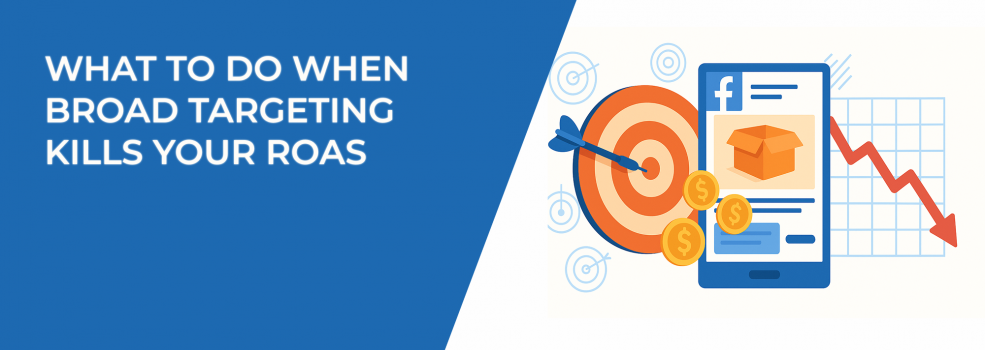Running Facebook ads with broad targeting can feel like gambling. Sometimes you hit the jackpot with new audiences and cheaper conversions. Other times, your return on ad spend (ROAS) crashes — and you’re left wondering where all that money went.
So, what can you do when broad targeting doesn’t deliver? Let’s dive in.
Why Broad Targeting Often Backfires
Broad targeting can be exciting. The promise is huge reach, less manual setup, and the chance to uncover buyers you never would have found with narrow targeting.
But here’s the catch — the algorithm isn’t perfect. It might send your ads to thousands of people who scroll past without even noticing. And if you’re paying for all those impressions, your ROAS takes the hit.
Picture this:
-
You sell high-end running shoes. Instead of narrowing by running interest, you let Facebook target all adults in the U.S. Some of those people might be serious athletes. But many won’t have run more than a block in years.
-
Or say you’re selling meal kits. Broad targeting shows your ads to everyone from busy parents to retirees with plenty of free time. Who’s more likely to convert? You can probably guess.
Broad targeting doesn’t always mean wasted money — but when you see declining returns, you need to investigate fast.
Step 1: Audit Your Audience Data
The first step is detective work. You need to know where the problem is before you fix it.
Check:
-
Age and gender splits. Maybe your ads perform well with women 25–34 but poorly with men over 45.
-
Placement performance. Is your money going into Reels while most purchases happen in the Feed?
-
Location data. Are certain states or cities bringing higher conversion rates while others drag you down?
Example: A DTC coffee brand ran broad targeting across the U.S. After checking breakdowns, they noticed most of their sales were coming from urban areas on the East Coast. Their ROAS improved once they cut back on regions where conversions never came in.
Also, before trimming campaigns, it helps to revisit the basics of targeting.
Step 2: Add Smart Layers
Broad doesn’t have to mean blind. Sometimes one or two filters can nudge the algorithm in the right direction.
Try layering in:
-
Interest signals. Selling high-ticket items? Add “luxury goods” or “online shoppers” to help filter the audience.
-
Age limits. A college prep service probably doesn’t need 50-year-olds in the mix.
-
Lookalikes. Build them from your best 5% of customers, not just everyone who’s ever purchased once.
Think of this like coaching a rookie player. You don’t take away all freedom, but you give them a playbook so they don’t run in circles.
Even small adjustments can steer broad campaigns in the right direction, and layered targeting.
Step 3: Use Creative as a Filter
Your creative is the real gatekeeper. When you target broadly, the ad itself decides who leans in and who scrolls by.
Bad creative attracts the wrong crowd. Good creative filters out people who were never going to buy.
For example:
-
Selling eco-friendly cleaning products? Instead of a bland headline like “Better for Your Home”, try “For Families Who Refuse Toxic Chemicals in Their Kitchen.” Instantly, you’re calling out your real buyer.
-
Promoting a productivity app? A generic line like “Stay organized” will draw curiosity clicks from people who never convert. Instead, use something sharper like “For Managers Who Hate Wasting Time in Meetings.”
Broad targeting makes sense only if your creative is working overtime. The right creative doesn’t just grab attention, it filters for quality leads — see how in this ad copy guide.
Step 4: Watch the Early Signals
Broad targeting can burn through budgets quickly. Don’t wait until it’s too late.
Keep an eye on:
-
CTR. If it’s far below your average after a few days, that’s a red flag.
-
CPM. Rising costs without more conversions usually means the wrong audience.
-
Conversion clustering. If almost all purchases are coming from a single subgroup, tighten your targeting around them.
Example: An online fitness coach launched a broad campaign targeting “all adults.” Within three days, 80% of sign-ups came from women in their 30s. The coach quickly narrowed the audience and doubled ROAS within a week.
Step 5: Balance with Retargeting
Broad campaigns are often top-of-funnel machines. They bring in volume, but not always buyers. That’s where retargeting saves your ROAS.
Imagine you’re running ads for a subscription snack box. Broad targeting gets thousands of curious clicks but few sales. Instead of cutting the campaign, retarget those visitors with ads showing unboxing videos or limited-time offers. Suddenly, the same traffic becomes profitable. Retargeting turns weak cold results into strong overall ROAS.
Here are some ways to make retargeting stronger:
-
Segment by behavior. Show one type of ad to people who visited your landing page but didn’t buy, and another to those who added to cart but abandoned checkout.
-
Shorten the window. Hot leads cool down quickly. A 3–7 day retargeting window often converts better than a 30-day one.
-
Highlight social proof. Use testimonials, reviews, or “as seen in” mentions to rebuild trust and push people over the edge.
-
Test formats. Carousel ads, video demos, or dynamic product ads can re-engage in different ways than your original broad ad.
-
Sweeten the deal. A small discount, bonus item, or free shipping for retargeted users can tip the scales in your favor.
Retargeting isn’t just about “reminding” people — it’s about tailoring the message to where they dropped off in the buying journey. Done right, it can transform a losing broad campaign into a profitable system.
Retargeting only works if it’s set up properly — here’s how to do it.
Step 6: Scale Carefully
If broad targeting does start to work, don’t let excitement kill it. Scaling too fast almost always breaks performance.
Instead:
-
Increase budgets gradually (20–30% at a time).
-
Monitor frequency so your audience doesn’t burn out.
-
Set a “hard stop” rule — for example, pausing any ad set that drops below a 2.0 ROAS for more than three days.
Think of scaling as adding weight at the gym. Too much at once and you injure the campaign. Slow and steady builds strength.
Final Thoughts
Broad targeting isn’t the villain — it’s a tool. But it’s a tool that can drain your budget if you don’t keep it on a short leash.
Audit your data. Layer in smart filters. Let your creative act as a gatekeeper. And always, always watch the signals before your ROAS gets crushed.
When broad targeting kills your ROAS, it doesn’t mean Facebook ads have stopped working. It just means you need to step in and guide the algorithm back to the buyers who matter.

